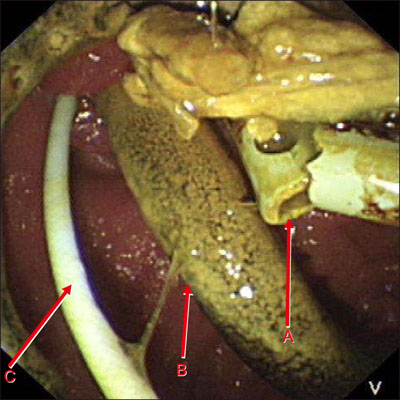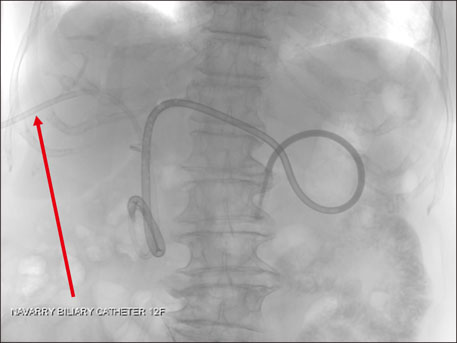Ann Hepatobiliary Pancreat Surg.
2018 Aug;22(3):282-286. 10.14701/ahbps.2018.22.3.282.
Percutaneous transhepatic biliary drainage catheter fracture: A case report
- Affiliations
-
- 1Lee Kong Chian School of Medicine, Nanyang Technological University, Singapore.
- 2Yong Loo Lin School of Medicine, National University of Singapore, Singapore.
- 3Department of Radiology, Khoo Teck Puat Hospital, Singapore.
- 4Department of General Surgery, Khoo Teck Puat Hospital, Singapore. vishal_g_shelat@ttsh.com.sg
- KMID: 2420618
- DOI: http://doi.org/10.14701/ahbps.2018.22.3.282
Abstract
- Percutaneous transhepatic biliary drainage (PTBD) is safe treatment for biliary decompression given certain indications. However, this is temporary until definitive drainage is established. We report on a 76-year-old lady with recurrent pyogenic cholangitis and PTBD catheter fracture. She had hepatitis B virus-related Child-Pugh class A liver cirrhosis, hypothyroidism, hyperlipidaemia, and previous atrial fibrillation with a background of mild mitral, tricuspid and aortic valvular regurgitation. She had history of laparoscopic cholecystectomy in the past. She was deemed to be a high operative risk and declined hepatic resection. She had undergone multiple endoscopic and percutaneous biliary interventions to control sepsis and stone burden. A bilateral PTBD catheter was left in situ with plans for 3-monthly change. However, she defaulted follow-up and presented 11 months later with complaints of pain over the drain site and inability to flush the right catheter. Abdominal X-ray and computed tomography scans detected right catheter fracture at two places, making three fragments. She underwent percutaneous removal of the proximal fragment by an interventional radiology team. A temporary 4 Fr catheter was inserted to maintain biliary access. Endoscopic removal of the intra-biliary fragments was done the next day. Complete removal was confirmed on fluoroscopy. Finally, the 4 Fr catheter was replaced by a new 12 Fr catheter. The patient was discharged well.
Keyword
MeSH Terms
Figure
Reference
-
1. Kwan KEL, Shelat VG, Tan CH. Recurrent pyogenic cholangitis: a review of imaging findings and clinical management. Abdom Radiol (NY). 2017; 42:46–56.
Article2. Strode MA, Bandera BC, Deveaux P, Rice RD. Migrated biliary stent complicated by small bowel obstruction. Am Surg. 2013; 79:E253–E254.
Article3. Hsien-Tzu L, Hsiuo Shan T, Nai Chi C, Yi Yang L, Yi You C, Chien An L. Percutaneous transhepatic techniques for retrieving fractured and intrahepatically dislodged percutaneous transhepatic biliary drainage catheters. Diagn Interv Radiol. 2017; 23:461–464.
Article4. Nghiem DD. Bile leakage after fracture of a percutaneous transhepatic biliary drainage catheter. JAMA. 1984; 251:892.
Article5. Arai M, Furuya M, Shimizu Y, Okino T, Yokomuro S, Arima Y, et al. A piece of catheter for liver abscess drainage was left in a liver due to fracture: report a case. Tando. 2010; 24:209–212.6. Luska G, Elgeti H, Lux M. Repeated breaks of polyurethane catheters as a complication of internal bile duct drainage. Rofo. 1981; 135:731–733.7. Takamatsu S, Nagano H, Ootsukasa S, Kawachi Y, Maruyama H. Ampullary carcinoma associated with removing fractured percutaneous transhepatic biliary drainage catheter for hilar cholangiocarcinoma. HPB. 2016; 18:e472.
Article8. Jensen LE, Collins Z, Lemons S, Johnson PL. Fracture of Navilyst Exodus biliary catheters. J Vasc Interv Radiol. 2011; 22:261–262.
Article9. Nennstiel S, Weber A, Frick G, Haller B, Meining A, Schmid RM, et al. Drainage-related complications in percutaneous transhepatic biliary drainage: an analysis over 10 years. J Clin Gastroenterol. 2015; 49:764–770.10. Seong CK, Kim YJ, Chung JW, Kim SH, Han JK, Kim HB, et al. Tubular foreign body or stent: safe retrieval or repositioning using the coaxial snare technique. Korean J Radiol. 2002; 3:30–37.
Article11. Siiki A, Rinta-Kiikka I, Sand J, Laukkarinen J. Endoscopic biodegradable biliary stents in the treatment of benign biliary strictures: First report of clinical use in patients. Dig Endosc. 2017; 29:118–121.
Article
- Full Text Links
- Actions
-
Cited
- CITED
-
- Close
- Share
- Similar articles
-
- Percutaneous transhepatic biliary drainage
- Peritonitis Caused by Internal Migration of the Percutaneous Transhepatic Biliary Drainage Catheter
- Subcutaneous Implantation Metastasis of a Cholangiocarcinoma of the Bile Duct after Percutaneous Transhepatic Biliary Drainage (PTBD)
- Percutaneous transhepatic removal of common bile duct stone: a case report
- Percutaneous biliary drainage in acute suppurative cholangitis with biliary sepsis





